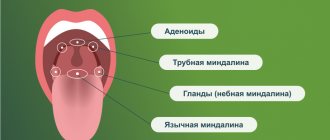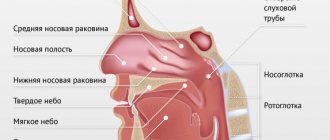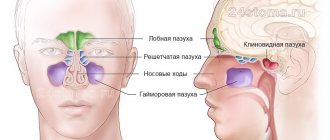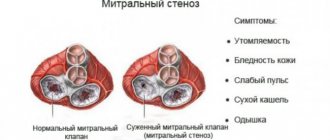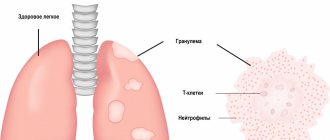Author:
- Elena Vitalievna Naumova, otolaryngologist, leading doctor of the clinic
3.00 (Votes: 10)
Acute tonsillitis with purulent exudate is considered the most common infection.
The disease occurs in both adults and children due to the entry of pathogenic microbes and bacteria into the oral cavity. It is not difficult to get a purulent sore throat even in the absence of direct contact with a sick person. Bacteria are spread through contact and airborne transmission, such as by sneezing or coughing in a public place or sharing household items.
Structure of the tonsils
The palatine tonsils, or tonsils, are an important organ of the human immune system. The tonsils are located in the oral cavity on both sides of the pharynx. The tonsils are shaped like an almond (hence the name “almond”) and range in size from one to four centimeters in diameter. The tonsils are endowed with a protective function. They are a kind of barrier to bacteria entering the body through airborne droplets, as well as through food intake. The structural features of the tonsils and the functions they perform are directly related to the appearance of tonsillitis plugs in the throat.
Make an appointment right now!
Call us by phone or use the feedback form
Sign up
On the surface of the tonsils, winding canals and openings are visible - lacunae and crypts.
When viruses from the outside enter the mouth, leukocytes in the tonsils are activated and begin an intensified process of forming antibodies that fight the “enemy.” At the same time, a signal is sent to all organs of the immune system, and the body comes into “combat readiness”.
What is tonsillitis?
Tonsillitis is an inflammatory process in the tonsils. The disease can be acute or chronic. The acute form is better known as tonsillitis. In chronic cases, periods of exacerbation (inflammation of the tonsils) are replaced by a period of remission (calm). Most often, the disease occurs in children 5-15 years old, although adults are also susceptible to the disease. The tonsils in children are larger than in adults. The palatine tonsils reach their maximum size by the age of 7, and then begin to shrink. Constant viral attacks on the tonsils lead to tonsillitis. Chronic tonsillitis most often acts as a complication after an infectious disease (sore throat, caries, etc.). The chronic form of the disease, according to statistics, occurs in 5% of adults and 11% of children. That is, chronic tonsillitis is a common disease. Tonsillitis plugs on the tonsils often appear with chronic tonsillitis.
Diagnosis of the disease
A diagnostic search for chronic tonsillitis is not only making a diagnosis, but also determining the form of the disease. Therefore, the examination is always comprehensive, which includes:
- Objective examination data (redness, swelling, injection of blood vessels on the tonsil mucosa, etc.);
- Survey – assessment of complaints, the history of their occurrence and other anamnestic information;
- Microbiological examination (seeding pathological secretions taken from lacunae on special media to determine the causative microbe, as well as its sensitivity to antimicrobial drugs);
- Laboratory tests (blood, urine);
- Instrumental examinations (ECG, ultrasound of the heart and lymph nodes).
Assessment of these parameters allows you to correctly determine the stage of the inflammatory process and optimally select treatment.
| Examination method | Signs | What does the examination give? |
| Collection of anamnesis and complaints | Pain and discomfort in the throat, sensation of a lump or foreign body, heart and joint pain, general weakness, malaise. Single or multiple exacerbations of tonsillitis throughout the year. | Allows you to suspect chronic tonsillitis and the stage of the process, and evaluate the effectiveness of the treatment. |
| Pharyngoscopy | Pus or purulent plugs on the surface of the tonsils (pathological secretion fills the lacunae). Redness, infiltration and swelling of the arches of the palate, their cicatricial fusion with the tonsil. | Confirms the diagnosis of chronic tonsillitis, but does not allow assessing the stage of the process. Allows you to evaluate the effectiveness of conservative treatment. |
| Bacteriological examination | Identification of the microorganism and its sensitivity to antibacterial therapy. | Allows you to identify the causative microorganism and select the necessary treatment. Assess the effectiveness of conservative treatment. |
| Laboratory diagnostics | Clinical blood test, biochemical blood test (urea, creatinine, ALT, AST), C-reactive protein, ASLO, rheumatoid factor, IgE, total blood IgA. | Allows you to determine the activity of inflammation, identify the risk of development or the presence of concomitant diseases (rheumatism, glomerulonephritis, polyarthritis, infective endocarditis, etc.) Helps choose treatment tactics, evaluate the effectiveness of treatment. |
| Functional diagnostics | ECG (electrocardiogram) Echo-CG (ultrasound of the heart) Ultrasound of the kidneys Ultrasound of the lymph nodes of the neck. | Helps determine the stage of chronic tonsillitis, identify the presence of associated diseases (rheumatism, glomerulonephritis, polyarthritis, infective endocarditis, etc.) Helps choose treatment tactics. |
Causes of chronic tonsillitis
The chronic form of tonsillitis often develops as a complication after a sore throat. Many patients try to cure a sore throat on their own and take medications uncontrollably. Some, having received doctor’s recommendations, do not follow the instructions and finish the course of taking antibacterial drugs earlier than expected, noticing an improvement. This is a huge mistake! Untreated sore throat causes the disease to enter the chronic stage and the formation of tonsillitis with purulent plugs. The main causative agents of the disease are streptococci and staphylococci.
Exacerbation of tonsillitis is favored by:
- chronic inflammatory process (sinusitis, caries, sinusitis, etc.);
- proliferation of adenoids;
- deviated nasal septum;
- damage to the tonsils;
- hypothermia;
- weak immunity.
Treatment of purulent sore throat
Purulent tonsillitis threatens serious complications from the heart, kidneys, joints and soft tissues of the neck if therapy is chosen incorrectly or treatment is started late. It is for this reason that it is important to immediately consult a doctor when the first signs of a sore throat appear.
The basic treatment regimen for acute tonsillitis with purulent exudate:
- Taking antibiotics of the penicillin group or the macrolide group. You can't do without them. General and local remedies are prescribed. Antibiotics kill pathogenic microflora and after a few days the production of pus stops, blood circulation in the tonsils is restored.
- Taking anti-inflammatory lozenges, lozenges, lozenges.
- Gargling and irrigating the throat with different solutions every hour.
- Use of local antiseptics in the form of a spray.
- Taking antipyretic drugs.
- Vitamin therapy and taking immunomodulators.
The principle of treatment of acute tonsillitis in children is similar, the only differences are in the dosage of medications. The patient needs to observe strict bed rest, talk less and gargle more often.
If the prescribed drug therapy does not have positive dynamics within several days, the patient continues treatment in the hospital.
Due to the presence of purulent plaque on the palatine tonsils, eating is difficult or completely impossible, so you can eat only pureed and liquid food, and also drink a lot of warm water to relieve symptoms of intoxication.
Why do traffic jams occur with tonsillitis?
The main factor in the formation of purulent plugs on the tonsils is the constant presence of a focus of inflammation, provoked by viruses. There are always bacteria in the human mouth - they are not dangerous to health. Once in the gaps, they are killed by immune cells. The tonsils of a healthy person are capable of self-cleaning - dead microorganisms are removed from the lacunae and enter the stomach with saliva, where they are destroyed under the influence of gastric juice.
But as soon as dangerous viruses enter the body, a large number of leukocytes are sent to fight them, the mucous membrane of the tonsils swells, and self-cleaning of the lacunae under such conditions becomes difficult. Dead bacteria and leukocytes begin to accumulate in the tonsils - purulent-caseous formations appear. If you do not consult an otolaryngologist in time and do not begin treatment for purulent tonsillitis plugs, the process can become irreversible and lead to the destruction of the tonsils.
Purulent formations and chronic tonsillitis
In the chronic form of the disease, inflammation in the tonsils does not completely disappear, but only subsides for a while. Bacteria are always present in the lacunae of the tonsils, and the increased formation of a large number of leukocytes does not stop. Since the chronic form is characterized by the absence of pronounced signs of the disease, the appearance of purulent plugs goes unnoticed by the patient. White blood cells surround the bacteria, and a purulent formation appears. Over time, substances containing calcium and magnesium accumulate in them. As a result, the plugs harden.
Among the reasons for the formation of traffic jams are:
- diseases of the nasal cavity that are chronic (for example, sinusitis) - some of the bacteria from the nose certainly gets into the throat;
- lack of proper oral hygiene - here bacteria are constantly present and when immunity decreases, they enter the tonsils; food debris can also get stuck in the gaps and become “material” for the hardening of purulent masses;
- weak immunity - a person is unable to cope with the infection on his own, and the disease becomes protracted or chronic;
- damage to the tonsils - infection can easily get into the wound. Often it is the site of injury that becomes the location of a new purulent formation.
Signs of tonsillitis
The most reliable local signs of chronic tonsillitis are:
- Hyperemia and roller-like thickening of the edges of the palatine arches.
- Cicatricial adhesions between the tonsils and palatine arches.
- Loose or scarred and hardened tonsils.
- Caseous-purulent plugs or liquid pus in the lacunae of the tonsils.
- Regional lymphadenitis is an enlargement of the cervical lymph nodes.
The diagnosis is made in the presence of two or more of the above local signs of tonsillitis. In the compensated form, there are only local signs of chronic inflammation of the tonsils, the barrier function of which and the reactivity of the body are still such that they balance and even out the state of local inflammation, i.e. compensate for it, so a pronounced general reaction of the body does not occur.
In case of decompensation, there are not only local signs of chronic inflammation, but also tonsillitis, paratonsillitis, paratonsillar abscesses, diseases of distant organs and systems (cardiovascular, genitourinary, etc.)
Any form of chronic tonsillitis can cause allergization and infection of the entire body. Bacteria and viruses located in the lacunae under appropriate conditions (cooling, decreased body resistance, and other reasons) cause local exacerbations in the form of sore throats and even peritonsillar abscesses.
Rice. 1. Chronic follicular tonsillitis. Rice. 2. Chronic lacunar tonsillitis. Rice. 3. Chronic tonsillitis (Preobrazhensky sign). Rice. 4. Chronic tonsillitis (Gise’s sign)
Symptoms of purulent plugs in the throat
Traffic jams are a factor by which chronic tonsillitis can be recognized. Therefore, when traffic jams appear, all the signs of this chronic disease are present. The following symptoms can be identified during an exacerbation of tonsillitis.
Constantly recurring sore throats - if there is inflammation in the tonsils, then this is not an indicator of chronic tonsillitis. But if a person is susceptible to the disease more than two or three times a year, then we can confidently say that we are dealing with a chronic form of the disease.
Friends! Timely and correct treatment will ensure you a speedy recovery!
The next symptom is redness and swelling of the palatine arches, to which inflammation from the tonsils can spread. Adhesions can form between the palatine arches and the tonsils - they seem to stick together with each other.
Enlarged lymph nodes are another sign of the disease. The manifestation of tonsillitis is accompanied by elevated body temperature. In the chronic form, a temperature of 37°C can last from several days to several weeks. The patient feels constant fatigue, lethargy, and performance decreases. All these are signals of adverse changes occurring in the body.
Clinical picture
Once a pathogen enters the body, two hours are enough for it to spread. Streptococci settle on the tonsils, weakening local immunity. The incubation period varies from several hours to 5 days.
The main differences between purulent tonsillitis are symptoms:
- A sharp pain in the throat occurs, which causes discomfort even at rest. The next day she becomes unbearable when talking or eating.
- Within a few hours, the body temperature rises to 39-40°C. Against the background of high temperature, it throws you either hot or cold, sweating increases and chills are present.
- Swallowing saliva causes severe, sharp pain.
- There is not enough air when breathing due to swelling of the tonsils.
- When examined with the naked eye, swollen tonsils and severe hyperemia of the back wall of the throat are visible. The next day the tongue and palate swell.
- There is a sensation of a foreign body in the nasopharynx, which intensifies when saliva is swabbed.
- Due to the fact that the tonsils are well supplied with blood, a yellowish-white dot appears on them, the boundaries of which quickly expand. The next day, the throat may become covered with many white purulent dots, which gradually merge into large ulcers.
Purulent tonsillitis in children occurs in a more severe form. Due to the excessive pressure of the swollen lymphoid tissue of the adenoids on the Eustachian tubes, the ears become blocked and there is tinnitus. If treatment is not attempted, the infection can spread to the ears, complicated by otitis media.
Usually the acute period lasts no more than one week if treatment is prescribed on time.
Important to know and remember! Purulent tonsillitis is a dangerous infectious disease, so the patient should be immediately isolated from household members.
Symptoms of purulent plugs in the throat
The first sign is a feeling that there is something in the throat: like a lump; A dry cough may accompany these unpleasant sensations. The patient has difficulty swallowing and has a sore throat.
Severe pain in the throat is accompanied by a putrid odor from the mouth, which cannot be muffled even with the help of toothpastes. This smell is the result of the activity of bacteria accumulated in traffic jams. Caseous formations are also visible upon visual inspection - curdled tubercles of a white-yellow hue are immediately noticeable on the tonsils. It happens that the pustules are not immediately visible, but as soon as you press on the surface of the tonsil, for example, with your tongue, these white-yellow tubercles begin to appear.
Blockages in the tonsils can bring a lot of unpleasant and even dangerous consequences to the patient: if the infection travels with the blood or lymph flow further through the body, it can cause problems with the heart, kidneys and joints. In order not to have to treat complications from tonsillitis, it is necessary to get an appointment with an otolaryngologist in a timely manner and begin treatment for tonsillitis with purulent plugs.
Acute tonsillitis - symptoms and treatment
If there are indications for hospitalization, the patient is given a referral for hospitalization to a 24-hour hospital in an infectious diseases hospital. When treating on an outpatient basis, the next day an application for an active home visit is submitted to the local therapist at the clinic at the patient’s place of attachment.
It is necessary to isolate the patient, frequently ventilate the room, wet cleaning, and ultraviolet irradiation of the air in the room with the patient. The patient is given a separate set of dishes; it is unacceptable to share towels or toothbrushes.
During the period of fever, the patient is shown semi-bed rest, and as the syndrome of intoxication and fever subsides - ward rest (until the 7th day of normal body temperature). The patient is advised to drink plenty of warm fluids, at least 1.5-2.0 liters of liquid per day. During therapy in a hospital setting, the administration of saline solution with ascorbic acid is indicated to reduce the symptoms of intoxication. When body temperature rises above 38 degrees, it is necessary to reduce it by taking 500 mg of paracetomol, 200-400 mg of ibuprofen, or 500 mg of paracetomol in combination with 200 mg of ibuprofen (drugs ibuklin, brustan). If the measures taken are ineffective, intramuscular administration of a lytic mixture (analgin 50% 1 ml + diphenhydramine 1% 1 ml), prednisolone in a dose of 30-60 mg (1-2 ml) is possible.
The patient is prescribed gargling with antiseptic solutions. On the pharmaceutical market there are common, affordable and at the same time effective antiseptics with a wide spectrum of activity and low resistance of microorganisms to them. Such drugs include chlorhexidine, miramistin, Yox.
The antibacterial (bactericidal) effect of Yox solution is realized due to iodine in its composition. The solution is diluted at the rate of 5 ml (1 teaspoon) per 100 ml of water. Rinse your throat at least 4 times a day. Before applying the spray, gargle with plain water to remove mucus. Apply the spray at least 4 times a day.
It is mandatory to prescribe an etiotropic drug to combat the causative agent of tonsillitis. In outpatient settings, oral administration of drugs is most convenient; in hospitals, parenteral administration is rational.[4]
When confirming the role of diphtheria rootbacillus in the development of the disease, the administration of equine anti-diphtheria serum is of primary importance. Before administering the main therapeutic dose, a biological test is performed twice. At the first stage, 0.1 ml of diluted serum from an ampoule, marked in red, is injected intradermally into the flexor surface of the forearm. When administered correctly, a small nodule is formed on the skin, dense to the touch. 0.1 ml of saline solution is injected intravenously into the forearm of the second arm as a control. The observation time for the patient is 20 minutes. The test is considered negative if the diameter of the papule or hyperemia at the injection site is no more than 10 mm. In the second stage, 0.1 ml of undiluted serum, marked in blue, is injected subcutaneously into the outer surface of the upper arm. In the absence of an adverse reaction, the main dose of the drug is administered intramuscularly after 30 minutes.
A single dose of serum is:
- for localized forms 10,000 – 20,000 IU;
- diphtheria of the larynx 40,000 – 50,000 IU;
- for subtoxic form 40,000 – 50,000 IU;
- toxic 50,000 – 80,000 IU;
- hemorrhagic 100,000 – 120,000 IU.
If there is no therapeutic effect, the administration of the serum can be repeated after 12-24 hours using the same doses.[5]
Among antibacterial drugs, it is recommended to prescribe macrolides - clarithromycin, midecamycin or josamycin:
- Clarithromycin is recommended in a dosage of 500 mg once a day orally for at least 7-10 days.
- Midecamycin in a dosage of 400 mg 3 times a day orally for at least 7-10 days.
- Josamycin is used in a dosage of 500-1000 mg twice a day orally. The duration of therapy is at least 7-10 days.
Therapy for gonococcal tonsillitis is carried out in a dermatovenerological clinic. Ceftriaxone 0.5 mg intramuscularly or levofloxacin 0.5 mg orally is prescribed as a single dose. Due to the high risk of concomitant chlamydial infection, doxycycline, 600 mg, is prescribed together with cephalosporins. The drug is prescribed in 2 doses with an interval of 1 hour (3 tablets of 100 mg 2 times).
In general viral infections (infectious mononucleosis, generalized herpetic infection, severe influenza), the development of acute tonsillitis is usually associated with the activation of opportunistic flora of the oropharynx. In addition to antiviral therapy, antibiotics are prescribed, as is the case with ordinary primary bacterial tonsillitis.
First-line drugs are clavulated penicillins. The use of unclavulated penicillin for the treatment of upper respiratory tract infections is not recommended due to the high resistance of the microflora to this antibacterial drug.[7]
Amoxicillin clavulonate is taken in a dosage of 875+125 mg 3-4 times a day orally for at least 7 days.
2-3 generation cephalosporins and macrolides
II generation cephalosporins:
Cefuroxime in tablets of 250 mg is prescribed at the rate of 1 tablet 2 times a day orally;
III generation cephalosporins:
- Cefixime in tablets of 400 mg is prescribed at the rate of 1 tablet 1 time per day orally;
- Cefotaxime in bottles of 1 g IM per 2 ml of 2% lidocaine, adding 1 ml of NaCl 0.9% 2 times a day for better dissolution; possible intravenous drip administration for at least 30 minutes;
- Ceftriaxone vials of 1.0 g IM per 2 ml of 2% lidocaine, adding 1 ml of NaCl 0.9% 2 times a day for better dissolution; possible intravenous drip administration for at least 30 minutes.
Fluoroquinolones, carbapenems and lincosamines are used as reserve drugs in most cases. Tetracycline antibiotics have gone out of practice due to the high resistance of flora to them and the impossibility of use in pregnant women and in pediatric practice.
To prevent the development of candidiasis, the issue of prescribing an antifungal drug is decided on an individual basis.
For the treatment of fungal tonsillitis, the prescription of systemic antimycotics is mandatory. It includes oral administration of antifungal antibiotics for 10–14 days (levorin, nystatin, amphotericin B, ketoconazole, fluconazole). Antiseptic rinses and inhalations with miramistin are prescribed locally.
If necessary, the patient is issued a certificate of incapacity for work or a student’s certificate with exemption from work and attendance at classes, respectively.[6]
Estimated periods of incapacity:
- catarrhal tonsillitis - 5-6 days;
- follicular - 6-8 days;
- lacunar - 8-9 days;
- fibrinous - 11-12 days;
- phlegmonous - 13-14 days.
The average period of temporary disability is 10-12 days.
Recovery criteria:
- normalization of body temperature within 5 days;
- absence of sore throat and pain on palpation of the submandibular lymph nodes;
- absence of pathological abnormalities in the general blood test, general urinalysis and ECG film.
It is possible to provide a note from the attending physician to the employer in any form regarding transfer to light work and release from night shifts for 2 weeks, if possible. Students and schoolchildren are given an exemption from physical education for 2 weeks.[6]
Treatment of tonsillitis plugs
The appearance of plugs indicates long-term inflammation occurring in the body, so the removal of purulent plugs must be combined with measures to treat chronic tonsillitis. Chronic tonsillitis should be treated by a competent otolaryngologist. Only an ENT doctor knows how to treat tonsillitis plugs effectively and safely. There is no need to try to get rid of pustules on your own at home. Many patients begin to put pressure on the tonsils, scraping off the “plaque” with a spoon and other improvised means. But this measure is ineffective - pus is removed only from the surface, but this is only the tip of the iceberg, the main problem is inside. Such inept actions often lead to injury to the tonsils, which will only provoke the appearance of new caseous formations.
Treatment of tonsillitis
Complex treatment of tonsillitis is carried out under the supervision of an otolaryngologist; self-medication in this case is unacceptable. During the treatment period, the patient is prescribed bed rest, a gentle diet, and plenty of warm drinks. It is necessary to gargle with antiseptic solutions, carry out antibacterial therapy, and take antihistamines to reduce swelling of the throat. At temperatures above 38°C, it is recommended to take antipyretic drugs. Antibacterial and anti-inflammatory drugs are used to treat tonsils. To free the tonsils from accumulated pus, lacunae are washed using the Tonsilor apparatus. Injections into the tonsils, injection of medicinal substances into the lacunae, and lubrication of the tonsils with antiseptics are also used.
For severe pain, it is recommended to use painkillers. To treat tonsillitis, various physiotherapeutic procedures are used: ultraviolet irradiation on the tonsil area, laser and magnetic laser therapy, electrophoresis, UHF, ultrasound, oil and alkaline inhalations.
When treating chronic tonsillitis, treatment can be either conservative or surgical. surgical treatment is used in the absence of positive dynamics in treatment, or the pathology has led to serious complications. During the operation, the tonsil is removed completely or only part of it. New methods of surgery are being used - laser lacunotomy or tonsillectomy using a surgical laser.
If you have symptoms of a sore throat or if you have a long-term, indolent sore throat, contact a medical professional. Modern equipment and the latest treatment methods allow us to provide the most effective care to patients with chronic and acute tonsillitis. Complex treatment of tonsillitis allows you to achieve excellent results and avoid surgical treatment or complications of the disease. You can make an appointment by calling the center or leaving a request on the website.
Conservative method of removing tonsillitis plugs
Conservative treatment consists of:
- Treatment with medications (antibiotics and the duration of treatment is prescribed directly by the ENT doctor. Treatment of chronic tonsillitis should begin at the time of exacerbation, not remission. As a rule, the patient is prescribed the drugs “Amoxicillin”, “Amoxiclav”, “Summamed”, “Azithromycin”, etc. .).
- Gargling (solutions of furatsilin, soda, decoctions of chamomile, St. John's wort, string, from pharmaceutical products - Miramistin, Rotokan, etc. are excellent).
- Inhalations (as agreed with the doctor).
- Rinsing the lacunae of the tonsils (the most effective method for removing purulent accumulations. Performed only by an otolaryngologist. Rinsing is carried out using a syringe or a TONZILLOR device.
When carrying out a course of rinsing, the patient's condition significantly improves, the tonsils look healthier, and are cleared of purulent accumulations.
With chronic tonsillitis, the period of remission of the disease increases.
Forms of purulent sore throat
There are two varieties:
- Purulent sore throat, affecting the lacunae of the tonsils. The infection is localized in the upper part of the throat and does not penetrate deeper. Purulent deposits are easily separated with a spatula.
- Purulent tonsillitis affecting the lymph nodes. The infection penetrates deeper and affects the lymphoid apparatus. Purulent exudate cannot be separated manually. The condition is extremely serious and threatens the formation of a peritonsillar abscess. Urgent medical attention and hospitalization are required.
Surgery
Tonsillectomy - removal of the tonsils - is the most radical way to get rid of the problem. It is used in the most extreme cases, when conservative methods do not bring the desired relief, and the indications for surgery must be quite serious. Before removing tonsils, you need to carefully weigh everything and first try a full range of conservative treatment measures. By removing the tonsils, you are deprived of a natural natural barrier against viruses and infections. You need to fight to preserve your tonsils to the last!
Tonsils are removed using a scalpel, laser or liquid nitrogen. Your ENT doctor will definitely tell you about all the intricacies and consequences of tonsillectomy.
Traditional medicine and preventive measures
Treatment with folk remedies for removing accumulated pus is not entirely effective - plugs located deep in the tonsil cannot be removed. With their help, you can only soften the surface of the plugs to facilitate their rejection and use herbal decoctions when gargling and disinfecting it.
To reduce the risk of traffic jams, you need to follow some simple tips:
- carefully monitor oral hygiene;
- treat sore throat and inflammation in the nose and mouth in a timely manner: sinusitis, frontal sinusitis, caries, stomatitis;
- avoid hypothermia;
- for chronic tonsillitis, follow the recommendations of your ENT doctor, do not forget about preventive complexes of physiotherapy and tonsil rinsing;
- Strengthen your immune system and try to lead a healthy lifestyle.
Treatment at the ENT Clinic of Doctor Zaitsev
Many years of experience of our doctors allows us to say with confidence that treating chronic tonsillitis is our specialty. The modern equipment of the clinic allows for effective and safe manipulations to treat tonsillitis and remove purulent plugs. Washing of the tonsils is carried out using all methods known in practice, including using a modified TONSILLOR nozzle, which has no analogues in other medical institutions. This is the know-how of our clinic. The modified attachment is much more effective than the usual one, completely safe, its use does not cause pain to the patient and is suitable even for small children.
Please make an appointment and come. We will be happy to help you.
